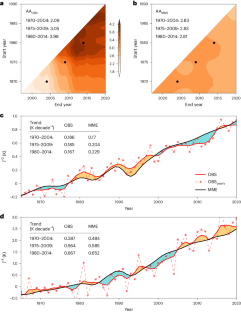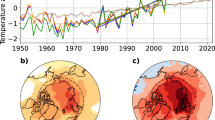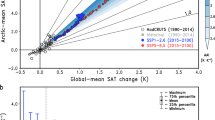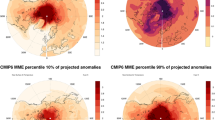Abstract
Arctic amplification—the amplified surface warming in the Arctic relative to the globe—is a robust feature of climate change. However, there is a considerable spread in the reported magnitude of Arctic amplification. Whereas earlier observations and model simulations suggested that the Arctic has been warming at a rate two to three times as the globe, a recent study reports an alarming amplification factor of four since 1979. Here we reconcile this discrepancy by revealing that natural variability has substantially modulated the degree of Arctic amplification. On the basis of three observational datasets and 34 models from the Coupled Model Intercomparison Project, we show that the observed temperature evolutions are distinct from the model-simulated forced responses and that the differences are explained by modes of natural variability. Specifically, the Interdecadal Pacific Oscillation decelerated global warming after 2000, whereas an Arctic internal mode amplified Arctic warming after 2005, both contributing positively to the recent increase of Arctic amplification to fourfold. By estimating and removing the effect of natural variability on the observed temperature changes, we reveal that the externally forced Arctic amplification has consistently remained close to three throughout the historical period.
This is a preview of subscription content, access via your institution
Access options
Access Nature and 54 other Nature Portfolio journals
Get Nature+, our best-value online-access subscription
$29.99 / 30 days
cancel any time
Subscribe to this journal
Receive 12 print issues and online access
$259.00 per year
only $21.58 per issue
Buy this article
- Purchase on Springer Link
- Instant access to full article PDF
Prices may be subject to local taxes which are calculated during checkout





Similar content being viewed by others
Data availability
The CMIP6 outputs are available from the Earth System Grid Federation (ESGF) portal at https://esgf-node.llnl.gov/search/cmip6/. The observation datasets of surface temperature are available at https://www.metoffice.gov.uk/hadobs/hadcrut5/ for HadCRUT, https://berkeleyearth.org/data/ for BEST and https://data.giss.nasa.gov/gistemp/ for GISTEMP. The ERA5 reanalysis data are available from the Copernicus data store at https://cds.climate.copernicus.eu/cdsapp#!/dataset/reanalysis-era5-complete?tab=overview. The outputs of the CESM2 experiment are available from the NCAR Climate Data Gateway at https://www.earthsystemgrid.org/dataset/ucar.cgd.cesm2.pacific.pacemaker.html for PPE and from the IBS openDAP server at https://climatedata.ibs.re.kr/data/cesm2-lens for the large-ensemble experiment for LE. The source data underlying the main figures are available at https://zenodo.org/records/10807270 (ref. 47). Source data are provided with this paper.
Code availability
The script for analyses and generating the main figures is available at https://zenodo.org/records/10807270.
References
CAPE-Last Interglacial Project Members. Last interglacial Arctic warmth confirms polar amplification of climate change. Quat. Sci. Rev. 25, 1383–1400 (2006).
Park, H.-S., Kim, S.-J., Stewart, A. L., Son, S.-W. & Seo, K.-H. Mid-Holocene Northern Hemisphere warming driven by Arctic amplification. Sci. Adv. 5, eaax8203 (2019).
Chapman, W. L. & Walsh, J. E. Recent variations of sea ice and air temperature in high latitudes. Bull. Am. Meteorol. Soc. 74, 33–48 (1993).
Serreze, M. C., Barrett, A. P., Stroeve, J. C., Kindig, D. N. & Holland, M. M. The emergence of surface-based Arctic amplification. Cryosphere 3, 11–19 (2009).
England, M. R., Eisenman, I., Lutsko, N. J. & Wagner, T. J. W. The recent emergence of Arctic amplification. Geophys. Res. Lett. 48, e2021GL094086 (2021).
Manabe, S. & Stouffer, R. J. Sensitivity of a global climate model to an increase of CO2 concentration in the atmosphere. J. Geophys. Res.: Oceans 85, 5529–5554 (1980).
Holland, M. M. & Bitz, C. M. Polar amplification of climate change in coupled models. Clim. Dyn. 21, 221–232 (2003).
Holland, M. M. & Landrum, L. The emergence and transient nature of Arctic amplification in coupled climate models. Front. Earth Sci. https://doi.org/10.3389/feart.2021.719024 (2021).
Deser, C., Tomas, R., Alexander, M. & Lawrence, D. The seasonal atmospheric response to projected Arctic sea ice loss in the late twenty-first century. J. Clim. 23, 333–351 (2010).
Wassmann, P., Duarte, C. M., Agustí, S. & Sejr, M. K. Footprints of climate change in the Arctic marine ecosystem. Glob. Change Biol. 17, 1235–1249 (2011).
Screen, J. A. Arctic amplification decreases temperature variance in northern mid- to high-latitudes. Nat. Clim. Change 4, 577–582 (2014).
Sun, L., Deser, C. & Tomas, R. A. Mechanisms of stratospheric and tropospheric circulation response to projected Arctic sea ice loss. J. Clim. 28, 7824–7845 (2015).
Wu, Y. & Smith, K. L. Response of Northern Hemisphere midlatitude circulation to Arctic amplification in a simple atmospheric general circulation model. J. Clim. 29, 2041–2058 (2016).
England, M. R., Polvani, L. M., Sun, L. & Deser, C. Tropical climate responses to projected Arctic and Antarctic sea-ice loss. Nat. Geosci. 13, 275–281 (2020).
Smith, D. M. et al. Robust but weak winter atmospheric circulation response to future Arctic sea ice loss. Nat. Commun. 13, 727 (2022).
IPCC Climate Change 2023: Synthesis Report (eds Lee, H. & Romero, J.) Ch. 12 (IPCC, 2023); https://www.ipcc.ch/report/ar6/wg1/chapter/chapter-12/
Arctic Climate Change Update 2021: Key Trends and Impacts. Summary for Policy-makers (AMAP, 2021); https://www.amap.no/documents/doc/arctic-climate-change-update-2021-key-trends-and-impacts.-summary-for-policy-makers/3508
Rantanen, M. et al. The Arctic has warmed nearly four times faster than the globe since 1979.Commun. Earth Environ. 3, 168 (2022).
Chylek, P. et al. Annual mean Arctic amplification 1970–2020: observed and simulated by CMIP6 climate models. Geophys. Res. Lett. 49, e2022GL099371 (2022).
Sweeney, A. J., Fu, Q., Po-Chedley, S., Wang, H. & Wang, M. Internal variability increased Arctic amplification during 1980–2022. Geophys. Res. Lett. 50, e2023GL106060 (2023).
Chylek, P. et al. High values of the Arctic amplification in the early decades of the 21st century: causes of discrepancy by CMIP6 models between observation and simulation. J. Geophys. Res.: Atmos. 128, e2023JD039269 (2023).
Meehl, G. A., Hu, A., Arblaster, J. M., Fasullo, J. & Trenberth, K. E. Externally forced and internally generated decadal climate variability associated with the Interdecadal Pacific Oscillation. J. Clim. 26, 7298–7310 (2013).
Dong, B. & Dai, A. The influence of the Interdecadal Pacific Oscillation on temperature and precipitation over the globe. Clim. Dyn. 45, 2667–2681 (2015).
Yulaeva, E. & Wallace, J. M. The signature of ENSO in global temperature and precipitation fields derived from the microwave sounding unit. J. Clim. 7, 1719–1736 (1994).
Kosaka, Y. & Xie, S.-P. Recent global-warming hiatus tied to equatorial Pacific surface cooling. Nature 501, 403–407 (2013).
Dai, A., Fyfe, J. C., Xie, S.-P. & Dai, X. Decadal modulation of global surface temperature by internal climate variability. Nat. Clim. Change 5, 555–559 (2015).
Mahajan, S., Zhang, R. & Delworth, T. L. Impact of the Atlantic Meridional Overturning Circulation (AMOC) on Arctic surface air temperature and sea ice variability. J. Clim. 24, 6573–6581 (2011).
Årthun, M., Eldevik, T., Smedsrud, L. H., Skagseth, Ø. & Ingvaldsen, R. B. Quantifying the Influence of Atlantic heat on Barents Sea ice variability and retreat. J. Clim. 25, 4736–4743 (2012).
Park, H.-S., Lee, S., Son, S.-W., Feldstein, S. B. & Kosaka, Y. The impact of poleward moisture and sensible heat flux on Arctic winter sea ice variability. J. Clim. 28, 5030–5040 (2015).
Screen, J. A. & Deser, C. Pacific Ocean variability influences the time of emergence of a seasonally ice‐free Arctic Ocean. Geophys. Res. Lett. 46, 2222–2231 (2019).
Warner, J. L., Screen, J. A. & Scaife, A. A. Links between Barents–Kara sea ice and the extratropical atmospheric circulation explained by internal variability and tropical forcing. Geophys. Res. Lett. 47, e2019GL085679 (2020).
Jeong, H., Park, H.-S., Stuecker, M. F. & Yeh, S.-W. Distinct impacts of major El Niño events on Arctic temperatures due to differences in eastern tropical Pacific sea surface temperatures. Sci. Adv. 8, eabl8278 (2022).
Deser, C., Walsh, J. E. & Timlin, M. S. Arctic sea ice variability in the context of recent atmospheric circulation trends. J. Clim. 13, 617–633 (2000).
Ding, Q. et al. Fingerprints of internal drivers of Arctic sea ice loss in observations and model simulations. Nat. Geosci. 12, 28–33 (2019).
Liu, Z. et al. Atmospheric forcing dominates winter Barents–Kara sea ice variability on interannual to decadal time scales. Proc. Natl Acad. Sci. USA 119, e2120770119 (2022).
Davy, R. & Griewank, P. Arctic amplification has already peaked. Environ. Res. Lett. 18, 084003 (2023).
Morice, C. P. et al. An updated assessment of near-surface temperature change from 1850: the HadCRUT5 data set. J. Geophys. Res.: Atmos. 126, e2019JD032361 (2021).
Lenssen, N. J. L. et al. Improvements in the GISTEMP uncertainty model. J. Geophys. Res.: Atmos. 124, 6307–6326 (2019).
Rohde, R. A. & Hausfather, Z. The Berkeley Earth land/ocean temperature record. Earth Syst. Sci. Data 12, 3469–3479 (2020).
Eyring, V. et al. Overview of the Coupled Model Intercomparison Project Phase 6 (CMIP6) experimental design and organization. Geosci. Model Dev. 9, 1937–1958 (2016).
England, M. R. Are multi-decadal fluctuations in Arctic and Antarctic surface temperatures a forced response to Anthropogenic emissions or part of internal climate variability? Geophys. Res. Lett. 48, e2020GL090631 (2021).
Hersbach, H. et al. The ERA5 global reanalysis. Q. J. R. Meteorolog. Soc. 146, 1999–2049 (2020).
Hahn, L. C., Armour, K. C., Zelinka, M. D., Bitz, C. M. & Donohoe, A. Contributions to polar amplification in CMIP5 and CMIP6 models. Front. Earth Sci. https://doi.org/10.3389/feart.2021.710036 (2021).
Rodgers, K. B. et al. Ubiquity of human-induced changes in climate variability. Earth Syst. Dyn. 12, 1393–1411 (2021).
Kay, J. E. et al. The Community Earth System Model (CESM) large ensemble project: a community resource for studying climate change in the presence of internal climate variability. Bull. Am. Meteorol. Soc. 96, 1333–1349 (2015).
Rosenbloom, N. CESM2 Pacific Pacemaker Ensemble. UCAR/NCAR–CISL–CDP https://doi.org/10.26024/GTRS-TF57 (2022).
Zhou, W. Steady threefold Arctic amplification of externally forced warming masked by natural variability. Zenodo https://doi.org/10.5281/zenodo.10807255 (2024).
Acknowledgements
This study was supported by Office of Science, US Department of Energy Biological and Environmental Research as part of the Regional and Global Model Analysis programme area. The Pacific Northwest National Laboratory (PNNL) is operated for DOE by Battelle Memorial Institute under contract DE-AC05-76RLO1830. We acknowledge the WCRP Working Group on Coupled Modeling, which is responsible for CMIP, and the climate modelling groups for producing and making available their model outputs. This research used resources of the National Energy Research Scientific Computing Center, which is supported by the Office of Science of the US Department of Energy under contract number DE-AC02-05CH1123. We also would like to acknowledge the data access and computing support provided by the NCAR CMIP Analysis Platform (https://esgf-node.llnl.gov/search/cmip6/).
Author information
Authors and Affiliations
Contributions
W.Z. designed the research and conducted the analysis. L.R.L. and J.L. contributed to improving the analyses and interpretation. W.Z. drafted the manuscript, and all the authors edited the paper.
Corresponding author
Ethics declarations
Competing interests
The authors declare no competing interests.
Peer review
Peer review information
Nature Geoscience thanks Mika Rantanen, Mark England and Mark Serreze for their contribution to the peer review of this work. Primary Handling Editor: Tom Richardson, in collaboration with the Nature Geoscience team.
Additional information
Publisher’s note Springer Nature remains neutral with regard to jurisdictional claims in published maps and institutional affiliations.
Supplementary information
Supplementary Information
Supplementary Table 1 and Figs. 1–12.
Source data
Source Data Figs. 1–5
Time series of the observed Arctic and global mean temperature, the MME Arctic and global mean temperature, the IPO index, the AM index and the influences of tropical Pacific variability on the Arctic and global mean temperature.
Rights and permissions
Springer Nature or its licensor (e.g. a society or other partner) holds exclusive rights to this article under a publishing agreement with the author(s) or other rightsholder(s); author self-archiving of the accepted manuscript version of this article is solely governed by the terms of such publishing agreement and applicable law.
About this article
Cite this article
Zhou, W., Leung, L.R. & Lu, J. Steady threefold Arctic amplification of externally forced warming masked by natural variability. Nat. Geosci. (2024). https://doi.org/10.1038/s41561-024-01441-1
Received:
Accepted:
Published:
DOI: https://doi.org/10.1038/s41561-024-01441-1



